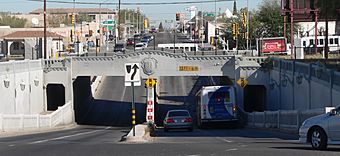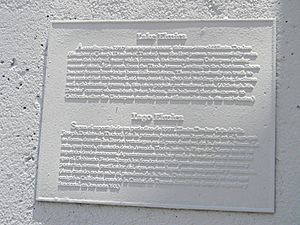Stone Avenue Underpass facts for kids
The Stone Avenue Underpass is a special tunnel for cars and people in Tucson, Arizona. It goes under the railroad tracks. Many local people call it "Lake Elmira." This is because it often fills with water when it rains a lot!
Quick facts for kids |
|
|
Stone Avenue Underpass
|
|
 |
|
| Location | Stone Ave., Tucson, Arizona |
|---|---|
| Area | 0.1 acres (0.040 ha) |
| Built | 1936 |
| Built by | Sundt, M.M. |
| Architectural style | Concrete Slab |
| MPS | Vehicular Bridges in Arizona MPS |
| NRHP reference No. | 88001656 |
| Added to NRHP | September 30, 1988 |
The Stone Avenue Underpass: Tucson's "Lake Elmira"
The Stone Avenue Underpass was finished in January 1936. It was built to help traffic flow smoothly under the busy railroad tracks. This important structure was added to the National Register of Historic Places on September 30, 1988. This means it is recognized as a special historical site.
Why is it Called "Lake Elmira"?
The underpass got its funny nickname, "Lake Elmira," because of a problem. It doesn't drain water very well. When there are heavy rainstorms, the underpass quickly fills up like a big puddle or even a small lake!
The name "Lake Elmira" comes from a story in 1937. A reporter named Howard Owetly worked for the Arizona Daily Star newspaper. It was summer, and not much news was happening in Tucson. Many people left the city to escape the heat before air conditioning was common.
The reporter needed a good story. He came up with a fun idea and named the "lake" after a 13-year-old girl named Elmira Doakes. This is how the legend of "Lake Elmira" began!
The Lake Elmira Plaque
In the 1980s, two young people who loved history decided to make a special plaque. They placed it on one of the underpass pillars. They did this without asking permission from the city or the Arizona Historical Society.
The plaque tells the story of Lake Elmira in both English and Spanish. It says that in 1937, Elmira Doakes was supposedly the first person to swim across the water that collected in the underpass during summer rains. The plaque also jokes that there was a rumor about the government not giving money to build docks or a cleaning system for this "popular recreational area."
It also mentions that Elmira Doakes might have moved to California. This was after the underpass got better drains in the mid-1960s. This made the "lake" less common.




